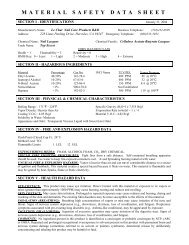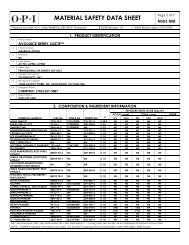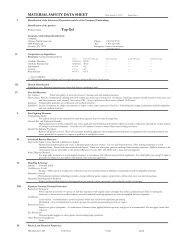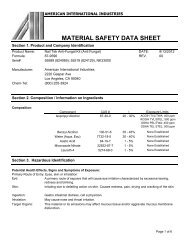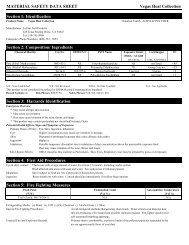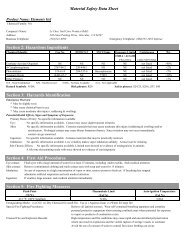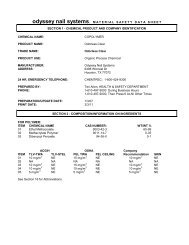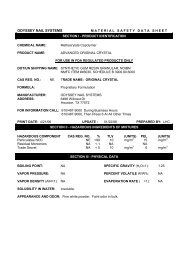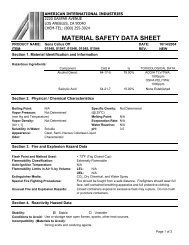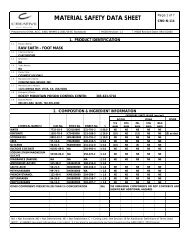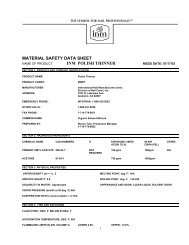87-9596 - Nail Tek Maximum Strength Anti-Fungal.pdf
87-9596 - Nail Tek Maximum Strength Anti-Fungal.pdf
87-9596 - Nail Tek Maximum Strength Anti-Fungal.pdf
Create successful ePaper yourself
Turn your PDF publications into a flip-book with our unique Google optimized e-Paper software.
AMERICAN INTERNATIONAL INDUSTRIES<br />
MATERIAL SAFETY DATA SHEET<br />
Section 1. Product and Company Identification<br />
Product Name: <strong>Nail</strong> <strong>Tek</strong> <strong>Maximum</strong> <strong>Strength</strong> <strong>Anti</strong>-<strong>Fungal</strong><br />
DATE: 9/13/2012<br />
Formula: <strong>87</strong>-<strong>9596</strong><br />
REV. 02<br />
Item#:<br />
Manufacturer:<br />
55519 (824129), NK33000<br />
American International Industries<br />
2220 Gaspar Ave<br />
Los Angeles, CA 90040<br />
Chem-Tel: (800) 255-3924<br />
Section 2. Composition / Information on Ingredients<br />
Composition:<br />
Component<br />
Isopropyl Alcohol<br />
CAS # %<br />
67-30-0 20 - 30%<br />
Exposure Limits<br />
ACGIH TVL/TWA: 400 ppm<br />
ACGIH TVL/STEL: 500 ppm<br />
OSHA PEL/TWA: 400 ppm<br />
OSHA TEL STEL: 500 ppm<br />
Benzyl Alcohol<br />
Water (Aqua, Eau)<br />
Acetic Acid<br />
Miconazole Nitrate<br />
Laureth-4<br />
100-51-6 35 - 45%<br />
7732-18-5 30 - 40%<br />
64-19-7 1 - 5%<br />
22832-<strong>87</strong>-7 1 - 5%<br />
5274-68-0 1 - 5%<br />
None Established<br />
None Established<br />
None Established<br />
None Established<br />
None Established<br />
Section 3. Hazardous Identification<br />
Potential Health Effects, Signs and Symptoms of Exposure:<br />
Primary Route of Entry: Eyes, skin or inhalation<br />
Eye:<br />
A primary route of exposre that will cause eye irritation characterized by excessive tearing,<br />
redness and blinking.<br />
Skin:<br />
Irritating due to defatting action on skin. Causes redness, pain, drying and cracking of the skin.<br />
Ingestion:<br />
Inhalation:<br />
Target Organs:<br />
Gastro intestinal distress, call a physician.<br />
May cause nose and throat irritation.<br />
This material or its emissions may affect mucous tissue and/or aggravate mucous membrane<br />
disfunction.<br />
Page 1 of 6
AMERICAN INTERNATIONAL INDUSTRIES<br />
Health Hazards<br />
(Resulting From<br />
Misuse or<br />
Overexposure):<br />
MATERIAL SAFETY DATA SHEET<br />
< 1000ppm chronic overexposure can be irritating to mucosal membranes. Prolonged<br />
overexposure may cause coughing, headaches, shortness of breath, dizziness, intoxication,<br />
anesthesia, drowsiness, unconsciousness, and other central nervous system effects, including<br />
death.<br />
Section 4. First Aid Measures<br />
First Aid for Eye:<br />
First Aid for Skin:<br />
Immediately rinse with clean water for 20-30 minutes. Retract eyelids often. Obtain emergency<br />
medical attention.<br />
Remove contaminated clothing. Wash skin thoroughly with mild soap/water. Flush with<br />
lukewarm water for 15 minutes. If sticky, use waterless cleaner first. Get medical attention if<br />
irritation develops.<br />
First Aid for Inhalation:<br />
If affected, remove individual to fresh air. If breathing is difficult, administer oxygen. If<br />
breathing has stopped, give artificial respiration. Keep person quiet, and get medical attention.<br />
First Aid for Ingestion:<br />
In case of accidental ingestion, consult a physician.<br />
Section 5. Fire Fighting Measures<br />
Flash Point (°F/°C):<br />
Flammable Limit<br />
(vol%):<br />
Auto-ignition Temp.<br />
(vol%)<br />
Extinguisher Media:<br />
Special Fire Fighting<br />
Procedures::<br />
Unusual Fire and<br />
Explosion Hazards:<br />
27.78°C (82°F) Tag Closed Cup<br />
LEL: 2.00%<br />
UEL: 12.7%<br />
Not available<br />
Foam, dry chemical, carbon dioxide<br />
Wear self-contained breathing apparatus with a full facepiece operated in the positive pressure<br />
demand mode. Fight fires from a safe distance/protected location. Heat may build<br />
pressure/rupture closed containers, spreading fire. Water may be ineffective in firefighting due<br />
Flammable. Vapors may cause a flash fire or ignite explosively. Vapors may travel<br />
considerable distance to a source of ignition and flash back. Prevent buildup of vapors or gases<br />
to explosive concentrations. Never use a welding or cutting torch on or near drum (even empty)<br />
because product (even just residue) can ignite explosively.<br />
Section 6. Accidental Release Measures<br />
Page 2 of 6
AMERICAN INTERNATIONAL INDUSTRIES<br />
Spill or Release<br />
Procedures:<br />
MATERIAL SAFETY DATA SHEET<br />
Release causes immediate fire/explosion hazard. Liquids/vapors may ignite. Evacuate/limit access.<br />
Equip respondents with proper protection. Extinguish all ignition sources. Stop release, prevent flow<br />
sewers/public waters. Restrict water use for cleanup. Notify fire/environmental authorities.<br />
Impound/recover large land spill. Blanket with fire fighting foam. Soap up small spill with inert solids.<br />
Use suitable disposal containers. On water, material is soluble and may float or sink. May biodegrade<br />
Contain and minimize dispersion; collect. Disperse residue. Report per regulatory requirements.<br />
Waste Disposal<br />
Methods:<br />
Contaminated product/soil/water may be RCRA/OSHA hazardous waste due to potentially low flash<br />
point. Landfill solids at permitted sites. Use registered transporters. Burn concentrated liquids in<br />
systems compatible with water soluble wastes. Avoid flameouts. Assure emissions comply with<br />
applicable regulations. Dilute aqueous waste. May biodegrade. Avoid overloading/poisoning plant<br />
biomass. Assure affluent complies with applicable regulations.<br />
Section 7. Handling and Storage<br />
Handling & Storing:<br />
Taken in Handling and Storage: This liquid is volatile and gives off invisible vapors. Either the<br />
liquid or vapor may settle in low areas or travel some distance along the ground or surface to<br />
ignition sources where they may ignite or explode.<br />
Section 8. Exposure Controls / Personal Protective Equipment<br />
Ventilation System:<br />
Local exhaust<br />
Respiratory<br />
Protections (Specific<br />
Type):<br />
If workplace exposure limit(s) of product or any component is exceeded (see Section I), a<br />
NIOSH/MSHA approved respiratory protection equipment as specified in the NIOSH/OSHA<br />
1981 Occupational Health Guidelines for Chemical Hazards..<br />
Skin Protection:<br />
Wear impervious protective clothing, including boots, gloves, lab coat, apron or coveralls, as<br />
appropriate, to prevent skin contact. Neoprene and nitrile rubber are recommended materials.<br />
Eye Protection:<br />
Other Protective<br />
Clothing and<br />
Eq ipment<br />
Hygienic Work<br />
Practices:<br />
Use chemical safety goggles and/or a full face shield where splashing is possible. Maintain eye<br />
wash fountain and quick-drench facilities in work area.<br />
Emergency eye wash fountain should be available. Impervious clothing and boots.<br />
Good Manufacturing Practices. Wash hands and other exposed areas with mild soap and water<br />
before eating drinking, smoking, and when leaving work.<br />
Section 9. Physical and Chemical Properties<br />
Appearance @ 25°C: Clear Liquid Viscosity (RVT): Not applicable<br />
Page 3 of 6
AMERICAN INTERNATIONAL INDUSTRIES<br />
MATERIAL SAFETY DATA SHEET<br />
Odor @ 25°C: Ester sweet Vapor Pressure: 44mmHg @ 20°C<br />
pH Not applicable Vapor Density: 2.1 (air=1)<br />
Specific Gravity: 0.96 Evaporation Rate: 2.83 (NBA = 1)<br />
Ignition:<br />
Not applicable<br />
Melting Point: Not applicable<br />
Boiling Point: 83°C (181°F)<br />
Solubility in Water Negligible<br />
Section 10. Stability and Reactivity<br />
Stability:<br />
Stable under ordinary conditions of use and storage. Heat and sunlight can contribute to<br />
instability.<br />
Hazardous Decomposition Products:<br />
Incomplete combustion may yield carbon monoxide and carbon dioxide, other toxic gases and<br />
acrid fumes.<br />
Incompatibility (Materials to Avoid):<br />
Strong oxidizers, open flame/sparks, aluminum metal, nitroform, oleum.<br />
Hazardous Polymerization:<br />
Will not occur.<br />
Conditions to Avoid:<br />
High temperatures. Strong oxidizing conditions.<br />
Section 11. Toxicological Information<br />
Acute Oral Toxicity:<br />
No data available<br />
Acute Toxicity to Invertebrates:<br />
No data available<br />
Acute Toxicity to Algae:<br />
No data available<br />
Irritation - Skin:<br />
Irritation - Eye:<br />
No data available<br />
No data available<br />
Sensitization: No data available<br />
Mutagenicity: None<br />
Sub-chronic Toxicity: None<br />
Page 4 of 6
AMERICAN INTERNATIONAL INDUSTRIES<br />
Section 12. Ecological Information<br />
Ecotoxicological Information<br />
Acute Toxicity to Fish:<br />
No data available<br />
Acute Toxicity to Invertebrates:<br />
No data available<br />
Acute Toxicity to Algae:<br />
No data available<br />
MATERIAL SAFETY DATA SHEET<br />
Bioconcentration:<br />
No data available<br />
Toxicity to Sewage Bacteria:<br />
No data available<br />
Chemical Fate Information:<br />
Biodegradability: No data available<br />
Chemical Oxygen Demand:<br />
No data available<br />
Section 13. Disposable Considerations<br />
Whatever cannot be saved for recovery or recycling should be handled as hazardous waste and sent to a RCRA<br />
approved incinerator or disposed in a RCRA approved waste facility. Processing, use or contamination of this product<br />
may change the waste management options. State and local disposal regulations may differ from federal disposal<br />
regulations. Dispose of container and unused contents in accordance with federal, state and local requirements.<br />
Section 14. Transportation Information<br />
<br />
Proper Shipping Name (49CFR 172.101): Alcohols, n.o.s.<br />
Hazard Class: 3<br />
UN/NA:<br />
UN19<strong>87</strong><br />
Packing Group:<br />
III<br />
Section 15. Regulatory Information<br />
Regulatory information available upon request.<br />
Page 5 of 6
AMERICAN INTERNATIONAL INDUSTRIES<br />
Section 16. Other Information<br />
MATERIAL SAFETY DATA SHEET<br />
Additional information available upon request.<br />
Page 6 of 6



